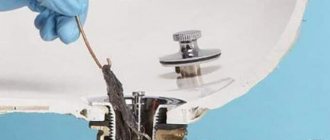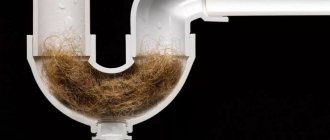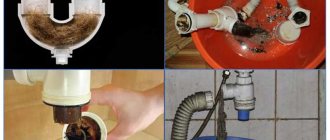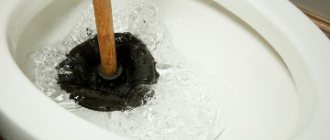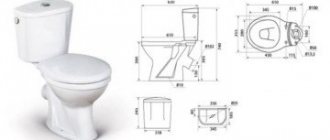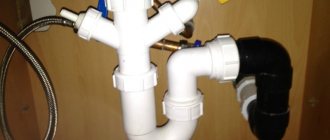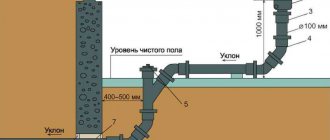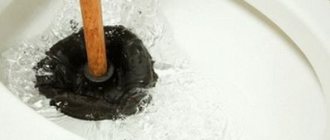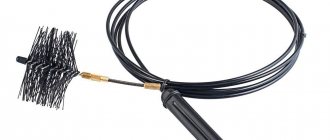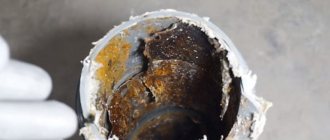Why doesn't the water in the sink drain?
The water in the sink begins to drain poorly due to a number of reasons, the first of which is a clog. The siphon with which the sink is equipped accumulates residual grease, pieces of food, detergents, and hair, which causes its diameter to narrow, so the liquid does not drain well.
A blockage can form due to a small object getting into the pipes: a bottle cap, a toy, a piece of paper, a paper clip. In this case, the plug that prevents the normal drainage of water from the sink may be located not in the siphon, but in some distant part of the pipe. Therefore, you can’t do without a special cable and a plunger.
Important! Don’t forget to prevent blockages by regularly flushing the sink with 2-3 liters of boiling water after each dishwashing.
Boiling water can only be poured into metal sinks; earthenware products will burst if they come into contact with too hot water. Be sure to use protective screens to prevent food particles and debris from entering the pipes.
Preventing blockages
There are techniques that will help keep your drainage systems in working order at all times. For example, the sink drain needs to be covered with a special mesh that traps debris and prevents it from getting into the pipes. If we are talking about metal sinks, then after each washing of dishes you need to pour 2-3 liters of boiling water down the drain. This advice is not suitable for earthenware sinks as they may burst when exposed to high temperatures.
You can eliminate the unpleasant odor from the drain using a solution of 50 ml of lemon juice and 70 g of baking soda. It needs to be sent to the drain and washed with hot water after 1 hour.
We use a plunger if the water in the sink does not drain
If the water drains slowly, then the best choice is a classic plunger. The product allows you to pump out water and air, which helps destroy the blockage. Using a plunger, it is worth closing the second drain with a stopper or a damp cloth; you can clear the blockage together, using 2 plungers respectively. Instructions for using the plunger are shown in the photo below.
What to do to prevent the sewer from getting clogged
You already know what not to throw down the drain, but there are also some other precautions. You need a mesh screen for your sink so that debris will not be able to get into the pipe. The cause of the blockage may be poor quality water that remains on the surface of the pipes. To avoid this, you need to install a water filter at home. Clean your pipes regularly. To do this, it is not necessary to use chemistry; you can use ordinary well-known folk methods.
Siphon cleaning
Even if the water in the kitchen sink drains normally, the siphon must be cleaned at least 2 times a year. The fact is that a variety of debris collects in this element of the water drainage system, which leads to severe blockages.
The most fragile girl can clean the siphon by following our instructions:
- wear gloves to protect your delicate hands;
- place a container under the siphon to collect water, spread a floor cloth;
- if there is a lot of water in the sink, wait until it drains slowly. If water does not pass through the pipes at all, then scoop it out;
- There is a cap at the bottom of the siphon that must be carefully unscrewed. Do not make sudden movements, otherwise liquid and debris will fly around the kitchen;
- the sealing ring made of rubber will fall out of the siphon. The ring must be preserved, because it will be useful to you;
- now it’s worth removing the blockage from the siphon using a sharp metal object (a screwdriver or a knife wrapped in an unnecessary piece of rag);
- now turn off the water tap to wash out small debris;
- If the water in the sink drains perfectly, then replace the o-ring and siphon cover, and then wipe the floor!
The work is not pleasant, but it helps to quickly remove the blockage without much material loss. Note that if after this procedure the water does not go away, then the blockage is located deep in the pipes, so it is necessary to use a cable.
How to disassemble and clean the siphon?
Did chemical compounds not help or are you unable to use them due to allergies? There is only one way out: unscrew the siphon and clean it manually.
For this:
- Turn off the water supply valves.
- Place a basin or cup under the drain (when you remove the bottom part, water will flow out).
- Unscrew the bottom and let the water drain out.
- Clean the siphon from dirt.
- Screw it back.
Important! Don't forget to check for leaks after assembly. Is the siphon leaking? Seal the threads.
Is it possible to clean the siphon without disassembling it?
You can clean the siphon without disassembling it, but in this case you will have to turn to traditional methods.
Method No. 1. We use baking soda and vinegar
If the water in the sink does not flow, then you can remove the blockage with the help of soda and vinegar. Remember that before starting the procedure, the water must be scooped out, after which you need to pour about 50-100 g of soda into the sink, pour it with 1 glass of vinegar. Now the drain needs to be closed with a stopper.
Wait 30-40 minutes, after which you should pour about 2 liters of boiling water into the sink. If the water flows better, we recommend using a plunger, which will help remove the remaining blockage efficiently.
Method No. 2 Salt, soda and boiling water
Proceed as described in method No. 1, removing excess moisture from the sink. Now follow these instructions:
- pour ½ cup each of salt and soda into the sink;
- pour the mixture with 0.5 liters of boiling water;
- leave the sink for 5-8 hours, remembering to close it with a stopper or a damp rag.
Then just rinse the sink with warm water, you can pour 1-2 liters of boiling water into it again.
Chemical method
How to clean a sewer pipe in the kitchen without using a plunger and cable? This question is very relevant, since both of the above tools involve the presence of unpleasant-smelling dirt during operation. Sometimes it is easier to resort to the help of special cleaning products developed by the modern chemical industry. The choice of such substances is quite extensive, and the most famous representative of this line is “Mole”, which is sold in liquid or powder form.
To remove a blockage in a kitchen pipe using a chemical method, it is important to follow the attached instructions exactly. As a rule, you need to pour or pour the product into the clogged pipe for a certain time, and then rinse it with plenty of hot water. In this way, the issue with weak and medium type plugs is usually resolved; more severe blockages will require calling a plumber or using a mechanical method.
Cleaning with a cable
The cable is a radical way to “treat” blockages, which has proven itself very well. First, you need to purchase a cable; it is better to choose a model equipped with a special handle. The cables are made of high-strength steel that is resistant to mechanical damage and corrosion, so such products will serve you for more than 50 years.
Using a cable, you must carefully place its end, equipped with a brush or hook, into the drain hole, after which the cable must be inserted into the pipe by turning a special handle. Sooner or later, the end of the cable will hit a blockage, at which point you must sharply push it inside, destroying the dirt plug. The method is labor-intensive, but it gives a 100% guarantee that the water will go away.
Advice! After destroying the blockage, be sure to rinse the pipes with plenty of boiling water. It is necessary to pour at least 5-7 liters of hot water into the sink.
How to clear a blockage mechanically
There are several ways to mechanically clear a clogged kitchen sink. They are simple, but require physical effort.
Using a plunger
If the drain is slightly clogged, when the water slowly but still drains away, it is best to use a plunger. It allows you to pump out water and air, gradually moving and destroying the formed lump. The scheme for working with a plunger is as simple as possible. The tool must be applied to the drain and pressed against the surface of the sink with a series of sharp pushes. If the plumbing has two drains, then you can work with a partner, armed with two plungers. When this is not possible, the second drain is covered with a damp rag or stopper.
If the drain is slightly clogged, when the water slowly but still drains away, it is best to use a plunger.
Cleaning with a cable
Cable cleaning is used in the most difficult cases, so its effectiveness is beyond doubt. A special cable can be purchased at a hardware store. When choosing a tool, preference should be given to a model with a comfortable handle, since working with such a cable will be the most comfortable and effective. High-quality cables are made from high-strength steel, which is resistant to corrosion and all kinds of damage. The service life of such a tool exceeds several decades.
The scheme for working with the cable is clear and accessible. The brush or hook located at the end of the tool is carefully inserted into the drain hole. After this, the cable is gradually pushed into the pipe, slowly turning the handle. As soon as the working end encounters a blockage, you should push it inside with a precise and sharp movement, thereby destroying the formed lump. Working with the cable requires some effort and skill, but its effectiveness exceeds expectations.
What household chemicals should I use if the water in the sink does not drain?
Household chemicals are one of the simplest, but also dangerous ways to clear clogs. Such products are produced in the form of powders, granules, liquids and gels, which are distinguished by an active formula that promotes the rapid destruction of blockages.
Remember that when working with such products you must follow a number of tips:
- use rubber gloves;
- if you use products in the form of powders, do not forget to wear a gauze bandage;
- Do not touch liquids and powders with bare hands; if they get on your skin or eyes, be sure to rinse the affected area with warm water.
Now let’s look at the most popular means that will help quickly remove blockages of any complexity.
Means "Mole"
The product is available in several forms; gel, powder, and liquid are highly effective. "Mole" has a number of advantages:
- low toxicity;
- high cleaning speed;
- guaranteed result;
- affordable price;
- absence of dirt, because the dissolved blockage goes into the pipes along with the water;
- economical consumption.
Using liquid products from this line, you need to pour about 250 ml of “Mole” into the sink, after which you should leave it for 1.5 hours. Rinse the pipes with water, you can forget about the blockage for at least 6-7 months!
Advice! You can buy the “Mole” product in the form of granules, in which case the contents of 1 package need to be poured into the sink and filled with 200 ml of warm water. After 1.5 hours, the pipes should be washed with hot liquid.
Sanfor product
The product is very effective, because it removes simple blockages in just 10-15 minutes; dissolving old dirt plugs takes about 25-30 minutes. Using Sanfor products is very simple:
- buy Sanfor gel, then pour about 250 ml into the sink, removing moisture from it;
- wait 5-30 minutes, the time depends on the severity of the disaster;
- check how the water drains in the sink by flushing it with a large amount of hot liquid.
The manufacturer recommends refilling the product if the blockage has not been completely destroyed. Sanfor products should be used once every 1-1.5 months to prevent the formation of complex dirt plugs.
Advice! After cleaning the sink, an unpleasant odor may remain, which you can eliminate with 50 ml of lemon juice and 70 g of soda. This mixture must be sent to the drain, left for 1 hour, and washed with hot water.
ORO-fix in powder form
The ORO-fix product efficiently dissolves clogs from organic substances, ensuring that the water in the sink drains quickly within 6-7 months after use. The main advantages of the product in powder form include the high speed of action and the fact that it does not have a negative effect on pipes made of plastic or metal. Using this product, simply add 2 tbsp. l. powder into the clogged sink, wait 30-60 minutes, then rinse the pipes with water.
Mechanical cleaning of sewer pipes
At home, you can mechanically clean pipes with a plunger or plumbing cable.
The plunger is a time-tested invention, inexpensive, and lasts a long time. You should buy a separate plunger for the kitchen; for hygiene reasons, you should not use the same one as in the bathroom.
The most reliable plunger is a wooden handle and a rubber pump base; plastic options are not so reliable. How to use it? We install it exactly above the sink drain, make sure that the rubber fits tightly to the bottom of the sink, and let the water flow. Let's take in enough water so that the rubber part of the plunger is under water, press vigorously with all our hearts a dozen times. If the blockage is small, the water will whistle down the drain. It is done!
What to do if your kitchen sink has two sections? Ideally, you should have a pair of plungers and work with them at the same time - this will provide you with excellent cleaning of the sewer system. If you don't have a second kitchen plunger, simply cover the other drain hole with your hand or a rag.
How to clear a clog without a plunger? If you don’t have it on your household, you can imitate its work with a glass, a hand in a rubber glove, or a rag. The principle of operation is the same: close the drain hole, fill with water, and sharply pull up.
Cleaning with a plumbing cable is not as simple as working with a plunger. But you can cope with it too! The cable is purchased at the store and must be used carefully.
The siphon is removed, the end of the cable is inserted there, with rotational movements of the handle the cable is pushed inside the sewer pipe and either crushes the resulting plug, or you take this mass out and throw it away. After installing the siphon in place, run hot water thoroughly. Enjoy the purity and freshness you deserve.
When working with plumbing cable, observe the following rules. The cable must be in good condition, without damage, the handle must be securely fastened to it.
You should rotate strictly in one direction at a measured speed; moving the handle randomly can damage the pipe. If suddenly the end of the cable gets stuck in the sewer, only in this case should you very carefully and slowly turn the handle in different directions until the obstacle is passed.
It is more convenient to carry out this procedure with two people - one regularly rotates the handle, the other controls the cable.
In modern apartments, the entire sewage system is interconnected. Before you start working in the kitchen, take a minute - go to the bathroom, plug the drain hole of the bathtub and sink, then go to the toilet and lower the toilet lid. These simple steps, which won’t take up your time and energy, will help you clean your kitchen sink more effectively.
You can also disassemble the drainage elements under the sink and manually clean each part. Only do this job if you are confident that you can handle it.
A selection of the best ways
There are several ways to clean a sink, and to solve the clog problem, you can try them all one by one until one of them gives a satisfactory result.
A clogged sink is the result of careless use of plumbing. Food waste, fat deposits or hair, soap bars and other particles clog the sink over time and water stops flowing out of it.
Method #1 - the good old plunger
Most often, the siphon in the sink that connects it to the sewer becomes clogged. It is designed in such a way that the drained water does not immediately flow from the sink into the sewer pipe, but is partially retained in it by means of a bend. The created water seal prevents the spread of unpleasant odors in the kitchen or bathroom. The easiest and most affordable way to remove a clog in a sink is to use an old, familiar plunger, which is found in almost every home. It helps, as a rule, in most cases, therefore it is a very popular method of restoring the outflow of water in case of blockages.
A classic plunger consists of a rubber cap with a wooden handle. When it is pressed, the plugs formed in the sink are destroyed under the influence of mechanical pressure. To clean a sink with a plunger, first fill it halfway with hot water and vigorously press it onto the drain, creating pressure differences. As a result, the blockage is destroyed and the water can drain freely.
A plunger is the simplest plumbing tool that should be in every home. This is the easiest and most common way to remove blockages in the sink.
You may also find these instructions useful for clearing clogged drains: .
If the reason your sink is clogged is due to small particles of food waste and debris, and if the clog is small, a plunger will do the job. And if the particles are large and the clog is quite old, a plunger may not be suitable for solving the problem. Then you will have to resort to other cleaning options.
Method #2 - chemicals
Unlike the previous option, there is no need to apply physical force here. Instead, everything will be done by special chemical compounds designed to remove blockages in sinks and sewer pipes. They contain various alkalis and acids that dissolve inorganic and organic compounds. Stores currently offer various means to remove blockages; you just need to choose the right one. For metal and metal-plastic pipes you should choose the “Mole” product, and “Tiret”, “Mr. Muscle”, “Domestos” are suitable for any pipes.
The purchased product must be poured into the drain pipe (while wearing protective rubber gloves) and waited for about five hours, but it is best to pour it overnight and pour boiling water into it in the morning. This type of cleaning may not work after the first attempt. Therefore, the actions with the chemical must be repeated, which, of course, is a disadvantage of this method of dealing with blockages. In any case, you should not refuse it; it is quite simple and cheap.
To eliminate blockages that have appeared, as well as to prevent their occurrence, special chemicals are used that dissolve mud deposits in pipes
Baking soda and vinegar essence are excellent folk remedies for clearing blockages in the sink. Gases and bubbles released as a result of a chemical reaction will help remove contaminants deposited on pipes
If there are no special chemicals in the house at the right time, you can use baking soda and vinegar essence. Pour a pack of soda into the drain, fill the bottle with 70% essence and after some time rinse with hot water.
Method #3 - disassemble and clean the siphon
When you have tried a plunger and dry cleaning, but the blockage still remains, you have to think about how to remove it, what other method to choose for this. There is a more radical option that will definitely help. This is disassembling and cleaning the siphon. This is where debris that has passed through the grate that covers the drain hole most often accumulates. This is facilitated by the curved shape of the pipe.
The surest way to remove a blockage in the sink is to dismantle and clean the siphon, where dirt deposits accumulate and prevent water from flowing out.
The procedure is as follows:
- we dismantle the siphon, this is done easily, especially if the siphon is plastic, do not forget to put a bucket under it;
- unscrew the lower and upper retaining rings, disconnect the siphon from the pipe;
- remove all debris from the inside, rinse with hot water and degreasers;
- if the siphon is corrugated, then remove it, wrap one end of the corrugation with polyethylene, pour in hot water and then tightly wrap the other end of the hose with film. Straighten it and perform circular movements. Water cleans all folds of the corrugation, washing away fatty deposits;
- We carefully put the structure back together and check how the situation has changed.
If the cause of the blockage was that the siphon was filled with garbage, then after cleaning it, the water will immediately leave the sink.
This procedure is much more difficult to perform with a cast iron siphon, since it will take a long time to unscrew the rusted bolts, remove the cover and then clean the pipe with a cable. Therefore, to easily solve the problem of blockage, it is better to install a modern plastic sewer system.
Method #4 - clean the pipes with a plumbing cable
There are times when the siphon has already been washed, but the water still slowly drains away. This means that dirt is stuck somewhere deep in the sewer pipe. In this case, you will need a plumbing flexible cable. Let's figure out how to break through the formed garbage plug using a cable to clear the blockage in the sink.
A flexible plumbing cable with or without different attachments will help break through the garbage plug that has formed in the depths of the sewer pipe, which will clear the blockage in the sink
Read recommendations for clearing blockages from bathtub and sink drains here:.
A plumbing cable is a three-meter long spiral-wrapped wire, one end of which looks like a spiral drill, and the other end ends with a handle. The thickness of the cable varies and is selected taking into account the width of the pipe. Here's how it's done:
- The end of the cable is pushed into the outlet pipe and directed towards the intended location of the blockage.
- At the same time, using the handle, the cable is constantly rotated around the longitudinal axis.
- After pushing the cable until it becomes clogged, you should make several back-and-forth movements with it, which will help destroy the dirt plug. We move the cable carefully so as not to damage the surface of the pipe, especially if the communications are old and have not been changed for a long time.
- We remove the cable and wash it from contamination.
After making sure that the blockage has been cleared, we rinse the pipes with a large amount of hot alkaline solution.
Video description
The effect of “Bagi Pothan” against plaque and pollution is clearly shown in this video clip:
"Mole" for blockages
"Mole" is a universal product for cleaning pipes. It contains potassium, sodium and acetic acid. This tandem removes heavy dirt and plaque. A significant advantage of the product is its low cost and effectiveness. In addition, it does not have an unpleasant odor and does not cause allergic reactions.
One application of "Mole" is enough for several months. To clean, pour a few spoons of the powdered product into the drain and leave it for 1 hour. After this, pour 1.5 liters of just boiled water into the pipe.
If the blockage is still not detected
If after completing all the procedures you see that the water is not draining well, but there is no blockage and you cannot find it, then the problem is not in your pipes. Perhaps this is a problem with the public sewer or the neighbor's. In this case, it is best to contact the staff of the utility service that services your home. They should send a technician to deal with the general sewer system.
Currently reading
- We repair chips on the bathtub with our own hands
- Installing faucets to an acrylic bathtub - easy with your own hands
- Simple reasons for hot water meters fogging
- We create a water leakage control system using improvised means
